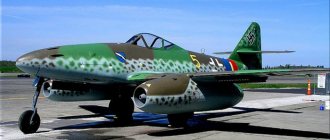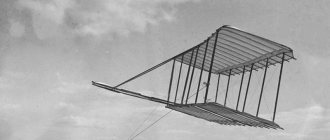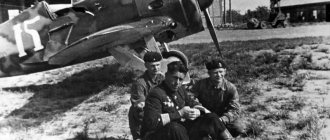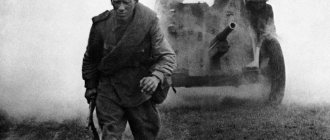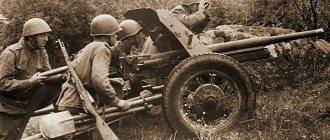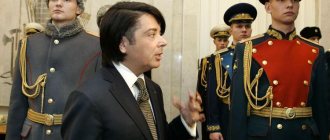Even before the war, the Yak-1 fighter was created at Yakovlev’s design bureau. Subsequently, its design will develop into the Yak-3 - one of the best Soviet aircraft in its class.
But the uniqueness of the situation is that Yakovlev’s fighters had an “internal competitor.” It became the Yak-7 aircraft; throughout the war it (and then its descendant the Yak-9) were produced in parallel with the “main line”. At the same time, the use of the Yak-7 as a fighter was not initially envisaged at all. This aircraft was conceived as a training aircraft for training pilots of “real” combat vehicles, including the Yak-1.
History of creation
At the end of the 30s, the Red Army began large-scale rearmament. Self-loading and automatic rifles were created for infantry. New tanks with three-inch guns and ballistic armor were being developed. Well, the task to develop a new generation of fighters was given to three design bureaus at once. But, in addition to combat vehicles, an aircraft was also required to train pilots.
The development of the training “spark” was entrusted to the design bureau of Alexander Yakovlev. Already in June 1940, the first prototype of the UTI-26 aircraft, based on the Yak-1 fighter, was built. In terms of piloting technique, the UTI-26 was quite close to two other fighters - the MiG-3 and LaGG-3.
In the fall of the same year, the aircraft was recommended for production launch and adoption.
In the spring of 1941, production of the “finished” version of the aircraft began, which received the new name Yak-7UTI.
After the start of the Nazi invasion, production of the Yak-7UTI was curtailed, but the produced aircraft were actively used - both for their intended purpose and as a reconnaissance aircraft. To do this, an observer was simply seated in the instructor's cabin. And then engineer Konstantin Sinelshchikov proposed making a combat fighter out of the training “sparky”.
It took little to achieve this - we strengthened the armament by installing another ShKAS machine gun, and a ShVAK cannon in the camber of the cylinder blocks. The pilot's cockpit was protected with an armored back, and the tanks were replaced with protected ones. And it turned out that, despite the skepticism of the chief designer, the Yak-7 fighter is even superior to the Yak-1 in stability and controllability. In the autumn of 1941, the combat Yak-7 went into production.
Production of Yak-7 aircraft (1941 - 1944)[1]
| Model | Factory | 1941 | 1942 | 1943 | 1944 | Total |
| Yak-7UTI | №301 | 186 | 186 | |||
| Yak-7 other modifications | №153 | 21 | 2211 | 2656 | 4888 | |
| №82 | 215 | 640 | 465 | 1320 | ||
| №21 | 5 | 5 | ||||
| TOTAL: | 207 | 2431 | 3296 | 465 | 6399 |
NOTES
- Statistics on the serial production of Yak-7 aircraft are given in the publication: History of the Domestic Aviation Industry. Serial aircraft construction, 1910-2010/Under the general editorship. YES. Soboleva. M.: RUSAVIA, 2011. - 432 p.: ill., p. 156 []
Design
The Yak-7 aircraft was a single-engine monoplane with a lower wing. The design was mixed: the fuselage frame was welded from pipes made of “chromansil” (steel with the addition of chromium, manganese and silicon), and sheathed with plywood and canvas. The engine hood and fairings are made of duralumin. The wing structure is made entirely of wood, the skin is made of plywood and canvas.
A 12-cylinder M-105 engine designed by Vladimir Klimov was installed on a removable motor mount.
The Yak-7 was equipped with the M-105PA modification, which allowed the installation of a motor gun in the camber of the cylinder blocks. Also, unlike the base model, floatless carburetors were used, allowing maneuvers with negative overloads.
Supercharging was carried out by a driven centrifugal supercharger. On later Yak-7s, an uprated M-15PF was installed - the engine power was increased by increasing the boost pressure.
Protected fuel tanks were located in the wings and under the cockpit. During production, they were additionally equipped with a pumping system with inert exhaust gases. The oil cooler was located under the engine, and the cooling system radiator was located under the pilot’s cockpit.
The first training Yak-7s were armed for training purposes with one ShKAS machine gun of 7.62 mm caliber. Combat fighters received a second machine gun and a 20 mm ShVAK cannon in cylinder camber. The ammunition of each machine gun consisted of 750 rounds of ammunition, the gun was equipped with a belt for 120 shells. In later modifications, machine guns were replaced by large-caliber UBS with ammunition capacity of 140 and 260 rounds (for the right and left, respectively).
In addition to small arms and cannon weapons, the fighter could carry 6 RS-82 unguided missiles. Later Yak-7Bs could also carry two bombs with a caliber of up to 100 kg.
The training aircraft had two cockpits with dual controls.
On fighter aircraft, of course, only the pilot had control, but the compartment behind his cockpit was preserved throughout production. This became a great advantage of the Yak-7, expanding its capabilities.
Historical reference
History of creation and combat use
May 9, 1939 OKB A.S. Yakovleva began developing the I-26 or Ya-26 light fighter. The chief designer was K.A. Vigant, hosted by K.V. Sinelshchikov. Initially, it was planned to install the promising M-106 liquid-cooled engine on the fighter, but development was delayed and its place was taken by the less powerful M-105P. In order to meet the original characteristics, it was necessary to redo the design in order to make it lighter, which immediately affected both the flight range and the equipment.
On January 13, 1940, the I-26 fighter took off for the first time, and on May 29, 1940, with some modifications, the aircraft was handed over for state tests. The production of the fighter was planned to be launched at factories No. 292 in Saratov and No. 301 in Khimki, and already in June 1940 the first vehicles began to enter the troops, under the same index - I-26, despite the fact that military tests of the vehicle were completed only after six months, already in 1941.
Before the start of the war, Soviet industry produced 425 Yak-1 aircraft. Hardly a quarter of this number reached combat units. In particular, in April 1941, 78 aircraft were sent to Baku, where they remained after the German attack.
By June 22, 1941, there were 105 Yak-1 aircraft in the five western military districts of the Soviet Union. It should be borne in mind that the aircraft were sent to the unit by rail in containers. In the Leningrad Military District there were 20 vehicles in the 158th Military District, in the Baltic Military District there were three vehicles, in the Western Military District there were 20 Yak in the 123rd, and in the Kiev Military District there were 62. In the Odessa Military District there were no Yaks at all. Almost all aircraft did not participate in the first battles, since only two regiments were combat ready: the 20th and 158th.
Most of the assembled Yak-1s were located in the interior of the territory as part of air defense units. The air defense pilots were better trained; they were in reserve. By the beginning of the war, the Moscow air defense system had 95 Yak-1s. They made up a significant share of the aircraft fleet during the Soviet counteroffensive near Moscow. In the data for November 1 and December 1, 1941, Yaks are absent, and on January 1, 1942, 14 Yak-1s appear again. The level of losses was quite high; the 6th Reserve Air Group had only one serviceable Yak-1. Thanks to its reliability and ease of maintenance, the Yak-1s from the 172nd regiment made 5-6 combat missions in a short winter day, which to some extent compensated for their small numbers. Yakami-1: 236th, 66th, 188th and 20th. The Kalinin Front also had four Yak-1 regiments: the 163rd, 518th, 521st and 237th.
Interesting Facts
On August 15, 1943, eight Yak-1s from the 236th IAP intercepted a group of German aircraft consisting of 60 bombers. The pilots were commanded by junior lieutenant V.P. Tikhonov.
On June 24, 1944, Soviet pilots conducted a demonstration battle. In battle E.Ya. Savitsky shot down one Fw 190 fighter-bomber, another Fokker was chalked up by I.F. Fedorov. At the end of the war, the 115th GIAP performed an unusual task. On April 29, 1945, an order arrived at the regiment: “Prepare the regiment for a parade flight on May 1, 1945 over Berlin. A six-meter flag was placed under the flaps of K. Novoselov’s Yak-3. 24 Yak-1s passed over the stands, commanded by A. Kose.
Serial modifications
Yak-7A - aircraft of the 1942 model. They began to install a radio station on them, and the aerodynamics were somewhat improved due to the retractable tail wheel. The transparent lantern was replaced with a plywood cover during production.
The Yak-7B is a modification created in the same 1942 with improved aerodynamics and enhanced weapons. The ShKAS machine guns on this fighter were replaced with 12.7mm UBS machine guns. The flight qualities of this Yak-7 not only did not deteriorate, but also increased to the level of the pre-war UTI-26. Since August 1942, the M-105PA engine was replaced with one boosted to 1180 hp. M-105PF.
Also on this Yak-7 during production, a new canopy appeared - teardrop-shaped, while the gargrot was lowered. All aircraft were equipped with radio stations, but most were equipped with only receivers. Only the commander's Yak-7 had the transmitters necessary to give orders. The fighters assigned to the air defense unit had additional means of night navigation - a radio compass and a powerful landing light.
The Yak-7-37 is a small-scale fighter armed with a 37 mm Sh-37 cannon designed by Shpitalny. Military tests demonstrated the high firepower of the aircraft (one hit from a high-explosive fragmentation projectile was enough to destroy an enemy fighter). Although production was not continued, the Yak-7-37 became the direct ancestor of the more famous Yak-9T.
The Yak-7V is a training aircraft with a simplified design. They were equipped with a non-retractable landing gear and fuel tanks without a protector. Armament was abolished altogether.
Increased supplies of aluminum made it possible to begin experiments to improve the characteristics of the Yak-7 through the use of duralumin in the design.
The experimental aircraft with duralumin wing spars was named Yak-7DI. His tests showed excellent results, but he was the last “seventh”. A similar fighter entered production under a different designation – the Yak-9.
Imitation of any fighter
The Italian M-346 is equipped with Western avionics and engines, the Russian Yak-130 is equipped with modern domestic avionics. On production Yak-130s, for the first time in Russia, a fully digital board without analog instruments, or a “glass cockpit,” was implemented. In the pilot's cockpit there are liquid crystal digital indicators (three for each pilot); in the front cockpit there is a collimator indicator against the background of the windshield.
One of the main advantages of the aircraft is the complex digital fly-by-wire control system developed by KRET, which allows you to perform aerobatic maneuvers and train pilots to control fighters of various classes. When teaching complex aerobatics and practicing air combat, the system makes it possible to bring the dynamic characteristics of the Yak-130 closer to simulated aircraft. Thus, at the helm you can practice air combat, missile and bomb attacks on ground targets, including simulating enemy air defense.
At the same time, the “smart” Yak-130 is ready to forgive future pilots many mistakes. Thanks to the latest electronics, the aircraft instantly responds to the commands of the instructor pilot. If the pilot being trained cannot cope with the controls, and the instructor in the cockpit is incapacitated for some reason, the Yak-130 can be landed by radio signal from the ground.
The aircraft also has a well-developed pilot ejection system. One of the key advantages is the ability to successfully eject at zero speed, as well as at low altitude through a specially destructible canopy glazing.
Combat use
For their original training purpose, the “sevenths” were used throughout the Great Patriotic War. And his contribution to the victory, made precisely in this role, is difficult to overestimate - after all, for a long time there were simply no other training “sparks” for fighter pilots.
However, the “seven” also performed remarkably well in its “unexpected” capacity as a fighter. Despite the fact that the “gross” fighters, due to low build quality, were initially inferior in performance to the reference models, the Yak-7 turned out to be easy to control and operate, and was also famous for its survivability.
And most importantly, the compartment remaining in place of the instructor’s cabin could be used both to accommodate equipment, such as a camera, and to transport people. For example, technicians during relocation or for throwing someone behind the front line.
Only in 1944 did the Yak-7 begin to be replaced by the Yak-9, while the last “sevens” were produced only in July.
Training aircraft were also used after the war. In addition to Soviet pilots, the Yak-7 was also flown by the French from the Normandie-Niemen squadron.
Mary Stuart
The most tragic fate in the entire history of this family was destined for Mary Stuart, the granddaughter of King James IV, who ruled Scotland in 1560-1567. It was she who became the mother of the future king of England, who was born in her marriage to Lord Henry Darnley. James VI of Scotland was born on June 16, 1566 at Edinburgh Castle and given the name James. Shortly afterwards his father G. Darnley was killed in an explosion caused by conspirators at his house in Kirk o' Fylde on 10 February 1567.
Mary Stuart, with the help of her associates, declared herself a contender for the English throne, but was defeated. When her son James was one year old, she was captured and imprisoned in Loch Leven Castle, where on July 24, 1567, she abdicated the crown in favor of her son. 20 years later she was executed by order of Queen Elizabeth Tudor.
Flight performance
Let's compare the Yak-7 with the main Luftwaffe fighter of the period 1941-1942. Bf.109F
| Yak-7B | Bf.109F-4 | |
| Wingspan, m | 10 | 9.9 |
| Length, m | 8.5 | 8.8 |
| Take-off weight, t | 3 | 3.1 |
| Maximum speed, km/h | 570 | 620 |
| Ceiling, km | 9,9 | 12 |
| Rate of climb, m/min | 862 | 1308 |
| Armament | 20 mm cannon, 2x12.7 mm machine gun | 20 mm cannon, 2x7.92 mm machine guns |
The Yak-7, inferior to the Messer in terms of climb speed, had an advantage in horizontal maneuvers. The UBS heavy machine guns were superior in power and armor penetration not only to the normal caliber MG17, but also to the 13 mm MG131, which would appear on German aircraft later.
On the other hand, the ammunition of the MG151 guns included the famous “minengeshoss” - high-explosive high-power shells, the allies had no analogues. The main drawback of the Yak-7 was the low build quality, due to which the speed characteristics of two fighters of the same series at the altitude limits differed by 10 km/h, and the altitude boundaries themselves could “shift” by hundreds of meters.
It deserves deep respect that the designers managed to turn an aircraft intended for a auxiliary role into a fighter for gaining air superiority.
Of course, the Yak-7 did not have record-breaking performance, and the build quality suffered greatly.
However, ease of assembly and operation, survivability and the ability to be used for other purposes (due to the compartment behind the cabin) are undeniable advantages. And the potential capabilities of the design were finally revealed on the Yak-9 aircraft.
Yak-3 Dimensions. Engine. Weight. Story. Range of flight. Service ceiling
Development of the aircraft under the designation Yak-1M began in August 1942. The aircraft was conceived as a deep modification of the Yak-16, optimized for gaining air superiority. Compared to the original model, the fuel supply was reduced by 11.5%, and the area of the wing and horizontal tail was significantly reduced. The wing was left wooden, like on the Yak-16, but the spars and four power ribs were made of duralumin. The armament remained the same as on the Yak-16 - a 20-mm LUBAK cannon firing through the propeller shaft (ammunition capacity of 120 rounds), and a synchronized 12.7-mm UB machine gun (200 rounds). As a result of the measures taken to lighten the vehicle, its take-off weight decreased by 280 kg.
Historical reference
History of creation and combat use
May 9, 1939 OKB A.S. Yakovleva began developing the I-26 or Ya-26 light fighter. The chief designer was K.A. Vigant, hosted by K.V. Sinelshchikov. Initially, it was planned to install the promising M-106 liquid-cooled engine on the fighter, but development was delayed and its place was taken by the less powerful M-105P. In order to meet the original characteristics, it was necessary to redo the design in order to make it lighter, which immediately affected both the flight range and the equipment.
On January 13, 1940, the I-26 fighter took off for the first time, and on May 29, 1940, with some modifications, the aircraft was handed over for state tests. The production of the fighter was planned to be launched at factories No. 292 in Saratov and No. 301 in Khimki, and already in June 1940 the first vehicles began to enter the troops, under the same index - I-26, despite the fact that military tests of the vehicle were completed only after six months, already in 1941.
Before the start of the war, Soviet industry produced 425 Yak-1 aircraft. Hardly a quarter of this number reached combat units. In particular, in April 1941, 78 aircraft were sent to Baku, where they remained after the German attack.
By June 22, 1941, there were 105 Yak-1 aircraft in the five western military districts of the Soviet Union. It should be borne in mind that the aircraft were sent to the unit by rail in containers. In the Leningrad Military District there were 20 vehicles in the 158th Military District, in the Baltic Military District there were three vehicles, in the Western Military District there were 20 Yak in the 123rd, and in the Kiev Military District there were 62. In the Odessa Military District there were no Yaks at all. Almost all aircraft did not participate in the first battles, since only two regiments were combat ready: the 20th and 158th.
Most of the assembled Yak-1s were located in the interior of the territory as part of air defense units. The air defense pilots were better trained; they were in reserve. By the beginning of the war, the Moscow air defense system had 95 Yak-1s. They made up a significant share of the aircraft fleet during the Soviet counteroffensive near Moscow. In the data for November 1 and December 1, 1941, Yaks are absent, and on January 1, 1942, 14 Yak-1s appear again. The level of losses was quite high; the 6th Reserve Air Group had only one serviceable Yak-1. Thanks to its reliability and ease of maintenance, the Yak-1s from the 172nd regiment made 5-6 combat missions in a short winter day, which to some extent compensated for their small numbers. Yakami-1: 236th, 66th, 188th and 20th. The Kalinin Front also had four Yak-1 regiments: the 163rd, 518th, 521st and 237th.
Interesting Facts
On August 15, 1943, eight Yak-1s from the 236th IAP intercepted a group of German aircraft consisting of 60 bombers. The pilots were commanded by junior lieutenant V.P. Tikhonov.
On June 24, 1944, Soviet pilots conducted a demonstration battle. In battle E.Ya. Savitsky shot down one Fw 190 fighter-bomber, another Fokker was chalked up by I.F. Fedorov. At the end of the war, the 115th GIAP performed an unusual task. On April 29, 1945, an order arrived at the regiment: “Prepare the regiment for a parade flight on May 1, 1945 over Berlin. A six-meter flag was placed under the flaps of K. Novoselov’s Yak-3. 24 Yak-1s passed over the stands, commanded by A. Kose.
Literature[ | ]
- Kondratyev Vyacheslav.
“The Magnificent Seven” (Russian) // Aviation Review. - Kh., 1995. - No. 2. - P. 9-18. - Kuznetsov S.D.
Yak-7. Total war fighter. - M.: Yauza; Eksmo, 2014. - 192 p. — (War and us. Aviation collection). — 1100 copies. — ISBN 978-5-699-75423-6. - Kharuk A.I.
Fighters of the Second World War. The most complete encyclopedia. - M.: Yauza, EKSMO, 2012. - 368 p. — 1500 copies. — ISBN 978-5-699-58917-3. - Smirnov G. Stories about weapons. - M., Detlit, 1976.



